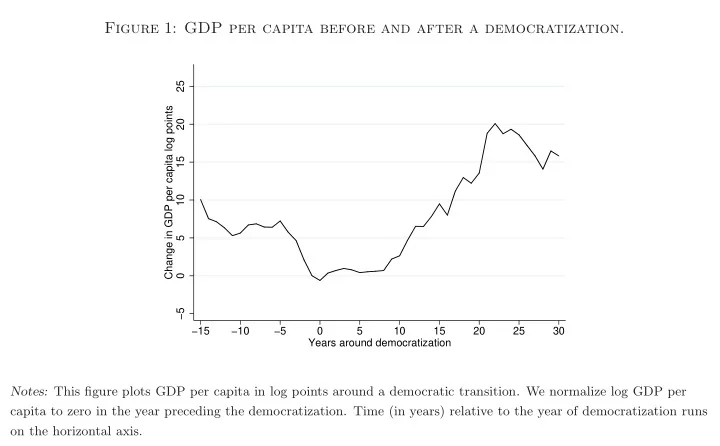

Figure 1: GDP per capita before and after a democratization. 25 Change in GDP per capita log points 20 15 10 5 0 −5 −15 −10 −5 0 5 10 15 20 25 30 Years around democratization Notes: This figure plots GDP per capita in log points around a democratic transition. We normalize log GDP per capita to zero in the year preceding the democratization. Time (in years) relative to the year of democratization runs on the horizontal axis.
Table 2: Effect of democracy on (log) GDP per capita. Within estimates Arellano and Bond estimates HHK estimates (1) (2) (3) (4) (5) (6) (7) (8) (9) (10) (11) (12) Democracy 0.973 0.651 0.787 0.887 0.959 0.797 0.875 0.659 0.781 0.582 1.178 1.682 (0.294) (0.248) (0.226) (0.245) (0.477) (0.417) (0.374) (0.378) (0.455) (0.387) (0.370) (0.352) log GDP first lag 0.973 1.266 1.238 1.233 0.946 1.216 1.204 1.204 0.938 1.158 1.150 1.155 (0.006) (0.038) (0.038) (0.039) (0.009) (0.041) (0.041) (0.038) (0.011) (0.038) (0.040) (0.036) log GDP second lag -0.300 -0.207 -0.214 -0.270 -0.193 -0.205 -0.217 -0.127 -0.122 (0.037) (0.046) (0.043) (0.038) (0.045) (0.042) (0.035) (0.050) (0.041) log GDP third lag -0.026 -0.021 -0.028 -0.020 -0.030 -0.040 (0.028) (0.028) (0.028) (0.027) (0.026) (0.024) log GDP fourth lag -0.043 -0.039 -0.036 -0.038 -0.039 -0.028 (0.017) (0.034) (0.020) (0.033) (0.015) (0.026) p-value lags 5 to 8 [ 0.565] [ 0.478] [ 0.094] Long-run effect of democracy 35.587 19.599 21.240 22.008 17.608 14.882 16.448 11.810 12.644 9.929 25.032 35.104 (13.998) (8.595) (7.215) (7.740) (10.609) (9.152) (8.436) (7.829) (8.282) (7.258) (10.581) (11.140) Effect of democracy after 25 years 17.791 13.800 16.895 17.715 13.263 12.721 14.713 10.500 10.076 8.537 20.853 29.528 (5.649) (5.550) (5.297) (5.455) (7.281) (7.371) (7.128) (6.653) (6.245) (6.032) (7.731) (7.772) Persistence of GDP process 0.973 0.967 0.963 0.960 0.946 0.946 0.947 0.944 0.938 0.941 0.953 0.952 (0.006) (0.005) (0.005) (0.007) (0.009) (0.009) (0.009) (0.009) (0.011) (0.010) (0.009) (0.009) AR2 test p-value [0.01] [0.08] [0.51] [0.95] Unit root test t − statistics -4.79 -3.89 -4.13 -7.00 p − value (reject unit root) [0.00] [0.00] [0.00] [0.00] Observations 6,790 6,642 6,336 5,688 6,615 6,467 6,161 5,513 6,615 6,467 6,161 5,513 Countries in sample 175 175 175 175 175 175 175 175 175 175 175 175 This table presents estimates of the effect of democracy on log GDP per capita. The reported coefficient on democracy is multiplied by 100. Columns Notes: 1-4 present results using the within estimator. Columns 5-8 present results using Arellano and Bond’s GMM estimator. The AR2 row reports the p-value for a test of serial correlation in the residuals of the GDP series. Columns 9-12 present results using the HHK estimator. In all specifications we control for a full set of country and year fixed effects. Columns 4, 8 and 12 include 8 lags of GDP per capita as controls, but we only report the p-value of a test for joint significance of lags 5 to 8. Standard errors robust against heteroskedasticity and serial correlation at the country level are reported in parentheses.
Figure 2: Dynamic panel model estimates of the over-time effects of democracy on the log of GDP per capita. 30 Change in GDP per capita log points 20 10 0 0 5 10 15 20 25 30 Years around democratization Notes: This figure plots the estimated change in the log of GDP per capita caused by a permanent transition to democracy. The effects are obtained by forward iteration of the estimated process for GDP modeled in equation (1). A 95% confidence interval obtained using the delta method is presented in dotted lines. Time (in years) relative to the year of democratization runs on the horizontal axis.
Table 5: Semi-parametric estimates of the effect of democratizations on (log) GDP per capita. -5 to -1 0 to 4 5 to 9 10 to 14 15 to 19 20 to 24 25 to 29 Average effects from: years years years years years years years (1) (2) (3) (4) (5) (6) (7) Panel A: Linear regression adjustment. Average effect of democracy on log GDP 0.060 2.454 3.621 7.806 14.037 24.075 21.310 (0.156) (1.382) (2.792) (4.416) (5.384) (8.262) (9.643) Panel B: Inverse propensity score reweighting. Average effect of democracy on log GDP -1.586 3.724 3.214 6.818 13.542 24.111 22.184 (1.478) (1.789) (3.327) (4.848) (5.892) (9.035) (11.561) Panel C: Doubly-robust estimator. Average effect of democracy on log GDP 0.051 2.795 2.969 6.966 12.947 23.691 21.793 (0.150) (1.478) (3.070) (4.354) (4.886) (7.674) (9.612) Notes: This table presents semi-parametric estimates of the effect of a democratization on log GDP per capita over different time horizons, indicated in the column labels. We report estimates of the average effect on the treated. Panel A presents estimates using regression adjustment to compute counterfactual outcomes for treated countries. Panel B presents estimates obtained via inverse propensity score reweighting. Panel C presents estimates obtained using a doubly-robust estimator, combining the regression adjustment and the inverse propensity score reweighting. Below each estimate we report robust standard errors obtained via bootstrapping.
Figure 6: Regional democratizations and reversal waves . .5 .4 Mean democracy .3 .2 .1 0 −10 −5 0 5 10 15 20 Years around first democratization in the region Initial nondemocracies in the region Initial nondemocracies in other regions 1 .95 Mean democracy .9 .85 .8 −10 −5 0 5 10 15 20 Years around first reversal in the region Initial democracies in the region Initial democracies in other regions Notes: These figures illustrate the existence of regional democracy waves. The top figure plots average democracy among initial nondemocracies around the first democratization in the region. For comparison it also plots average democracy among other initial nondemocracies in other regions. The bottom figure plots average democracy among initial democracies around the first reversal in the region. For comparison it also plots average democracy among other initial democracies in other regions.
Recommend
More recommend